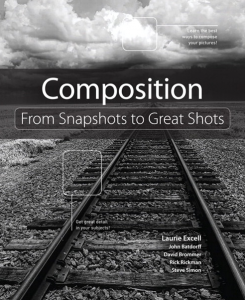Composition – From Snapshots to Great Shots
by Laurie Excell
Peachpit Press
272 pages,
SBN-10: 0-321-74132-3, SBN-13: 978-0-321-74132-5
$24.99 US, $29.99 CN
This is an odd “how to” book that purports to teach the amateur photographer the skill of arranging shapes and elements in a scene to create better pictures. The book is a collection of essays by wildlife photographer Laurie Excell and four other professional photographers. Based on the mission described in the introduction and the level of information in subsequent chapters, the book is clearly aimed at the amateur or hobbyist. What makes it odd is that it seems to quickly lose sight of its intended audience.
For example, the first chapter basically says if you really want good pictures. you’ll need to drop more than $20,000 into cameras and accessories, starting with an initial outlay of $8,000 for a Nikon D3X body. Ms Excell’s personal shopping list includes a bunch of fine Nikon lenses for the D3 and concludes, almost laughably, with a microfiber cleaning cloth. There is no question that everything on her list (and I’m just guessing the the cost of all that gear) would be a delight to own and would undoubtedly help the professional or the hobbyist make better images, but for an amateur this list is the equivalent of telling a beginning piano student to go out and buy a Steinway grand.
Further, while the title of the book suggests the focus will be on composition, fully one-third of the text and illustrations (some 80 pages) are dedicated to the kind of basic information easily found in almost any photography book. Chapter 1 is dedicated to equipment, Chapter 2 to the exposure triangle (combining ISO, aperture and shutter speeds) and Chapter 3 is dedicated to light. All of these basics are explained with reasonable skill and are accompanied by clear and informative graphics. No problem there. And the illustrations complement the text so effectively that after a cursory reading of the written text I found that a glance at the graphic told me everything I needed to know. But it takes a long time before anybody starts talking about composition.
I find that books this kind are more useful as reference guides. While there’s always the temptation to start at the beginning and plow through to the end, it’s sometimes more useful to go right to the index and pick out a couple of subjects. This was especially true in this book because the writing skills of the photographers varied so widely.
There are always hazards when compiling what amounts to an anthology or collection of essays by several different photographers. Some, like photographer David Brommer, write thoroughly engaging prose; others can’t seem to escape the passive voice and lull us with lifeless sentences. Some are very clear and provide useful tips, others belabor the obvious. One photographer tells us, for example, that if the light is good and he’s shooting at a fast enough shutter speed, he doesn’t need a tripod. If the book were aimed at someone picking up a camera for the first time, that might be useful, but if you’ve already dumped $20,000 into photo equipment, I have a feeling you’d know when to use a tripod and when to leave it home.
The book is abundantly illustrated with photos accompanied by the settings the photographer used to make the shot. Aside from the assignments recommended as lessons at the end of each chapter, these visual tutorials are great learning tools that encourage the photographer to stick the book in his pack and go out and experiment. In places the book’s designers included four or five shots of the same scene, each with a different combination of aperture and shutter speed to illustrate the different effects that each combination of settings produces.
Production values are consistently high. Composition is a soft-cover book printed on heavy stock.
MYMAC REVIEW RATING: 5 OUT OF 10


Leave a Reply
You must be logged in to post a comment.